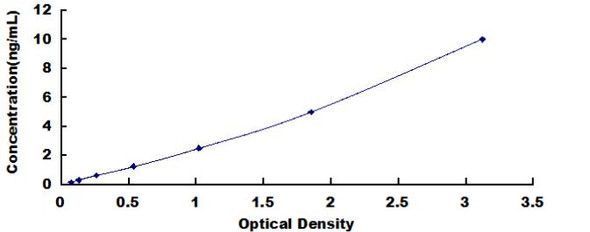Human Alpha B Crystallin / CRYAB ELISA Kit
- SKU:
- HUFI00546
- Product Type:
- ELISA Kit
- Size:
- 96 Assays
- Uniprot:
- P02511
- Sensitivity:
- 0.094ng/ml
- Range:
- 0.156-10ng/ml
- ELISA Type:
- Sandwich
- Synonyms:
- CRYalphaB, Crystallin Alpha B, CRYAB, CRYA2, CTPP2, HSPB5, alpha B crystallin, alpha, B-crystallin, alpha-crystallin B chain, alpha crystallin B chain, Heat shock protein beta-5, heat-shock 20 kD like-protein, Renal carcinoma antigen NY-REN-27, Rosen
- Reactivity:
- Human
- Research Area:
- Cell Biology
Description
Human Alpha B Crystallin / CRYAB ELISA
Many neurological diseases are associated with elevated alpha-B crystallin expression (CRYAB), and a missense mutation is co-segregated in a family with a desmin-related myopathy. Myofibrillar, 2, and cardiomyopathy, dilated 1Ii are examples of additional CRYAB (Crystallin alpha-B) related diseases. Protein homodimerization activity and microtubule-binding are among the GO annotations associated with CRYAB. LOC102724652 is a paralog of CRYAB. Alpha, beta, and gamma lens crystallins are the three families of mammalian lens crystalline. Alpha crystallins are made up of two subtypes: alpha-A (acidic) and alpha-B (basic). Alpha-A expression is restricted to the lens, while alpha-B is expressed throughout the body. Heat shock can stimulate alpha crystallins, which are part of the small heat shock protein (HSP20) family. Alpha crystallins are molecular chaperones but they do not function as traditional molecular chaperones; instead, they maintain proteins in large soluble aggregates. Each aggregate includes 30-40 subunits; the alpha-A and alpha-B subunits have a 3:1 ratio. Additional functions of alpha crystallins' includes autokinase activity and involvement in the intracellular structure. Based on its capacity to execute mechanistically distinct activities, Alpha B Crystallin has been termed a moonlighting protein.
| Product Name: | Human Alpha B Crystallin / CRYAB ELISA Kit |
| Product Code: | HUFI00546 |
| Size: | 96 Assays |
| Alias: | CRYalphaB, Crystallin Alpha B, CRYAB, CRYA2, CTPP2, HSPB5, alpha B crystallin, alpha, B-crystallin, alpha-crystallin B chain, alpha crystallin B chain, Heat shock protein beta-5, heat-shock 20 kD like-protein, Renal carcinoma antigen NY-REN-27, Rosenthal fiber component |
| Detection method: | Sandwich ELISA, Double Antibody |
| Application: | This immunoassay kit allows for the in vitro quantitative determination of Human CRYAB concentrations in serum plasma and other biological fluids. |
| Sensitivity: | 0.094ng/ml |
| Range: | 0.156-10ng/ml |
| Storage: | 4°C for 6 months |
| Note: | For Research Use Only |
| Recovery: | Matrices listed below were spiked with certain level of Human CRYAB and the recovery rates were calculated by comparing the measured value to the expected amount of Human CRYAB in samples. | ||||||||||||||||
| |||||||||||||||||
| Linearity: | The linearity of the kit was assayed by testing samples spiked with appropriate concentration of Human CRYAB and their serial dilutions. The results were demonstrated by the percentage of calculated concentration to the expected. | ||||||||||||||||
| |||||||||||||||||
| CV(%): | Intra-Assay: CV<8% Inter-Assay: CV<10% |
| Component | Quantity | Storage |
| ELISA Microplate (Dismountable) | 8×12 strips | 4°C for 6 months |
| Lyophilized Standard | 2 | 4°C/-20°C |
| Sample/Standard Dilution Buffer | 20ml | 4°C |
| Biotin-labeled Antibody(Concentrated) | 120ul | 4°C (Protect from light) |
| Antibody Dilution Buffer | 10ml | 4°C |
| HRP-Streptavidin Conjugate(SABC) | 120ul | 4°C (Protect from light) |
| SABC Dilution Buffer | 10ml | 4°C |
| TMB Substrate | 10ml | 4°C (Protect from light) |
| Stop Solution | 10ml | 4°C |
| Wash Buffer(25X) | 30ml | 4°C |
| Plate Sealer | 5 | - |
Other materials and equipment required:
- Microplate reader with 450 nm wavelength filter
- Multichannel Pipette, Pipette, microcentrifuge tubes and disposable pipette tips
- Incubator
- Deionized or distilled water
- Absorbent paper
- Buffer resevoir
| Uniprot | P02511 |
| UniProt Protein Function: | CRYAB: a major structural protein of the eye lens. A member of the small heat shock protein (sHSP also known as the HSP20) family. Alpha-B is expressed in the lens as well as other tissues. Elevated expression of alpha-B crystallin occurs in many neurological diseases; a missense mutation cosegregated in a family with a desmin-related myopathy. |
| UniProt Protein Details: | Protein type:Heat shock protein; Chaperone Chromosomal Location of Human Ortholog: 11q22.3-q23.1 Cellular Component: actin filament bundle; cell surface; cytoplasm; cytosol; Golgi apparatus; microtubule cytoskeleton; mitochondrion; myelin sheath; nucleoplasm; nucleus; plasma membrane; Z disc Molecular Function:identical protein binding; metal ion binding; microtubule binding; protein binding; protein homodimerization activity; structural constituent of eye lens; unfolded protein binding Biological Process: aging; lens development in camera-type eye; microtubule polymerization or depolymerization; muscle contraction; muscle development; negative regulation of apoptosis; negative regulation of caspase activity; negative regulation of cell growth; negative regulation of intracellular transport; protein folding; protein homooligomerization; response to estradiol stimulus; response to hydrogen peroxide; response to hypoxia; stress-activated MAPK cascade; tubulin folding Disease: Cardiomyopathy, Dilated, 1ii; Cataract 16, Multiple Types; Myopathy, Myofibrillar, 2; Myopathy, Myofibrillar, Fatal Infantile Hypertonic, Alpha-b Crystallin-related |
| NCBI Summary: | Mammalian lens crystallins are divided into alpha, beta, and gamma families. Alpha crystallins are composed of two gene products: alpha-A and alpha-B, for acidic and basic, respectively. Alpha crystallins can be induced by heat shock and are members of the small heat shock protein (HSP20) family. They act as molecular chaperones although they do not renature proteins and release them in the fashion of a true chaperone; instead they hold them in large soluble aggregates. Post-translational modifications decrease the ability to chaperone. These heterogeneous aggregates consist of 30-40 subunits; the alpha-A and alpha-B subunits have a 3:1 ratio, respectively. Two additional functions of alpha crystallins are an autokinase activity and participation in the intracellular architecture. The encoded protein has been identified as a moonlighting protein based on its ability to perform mechanistically distinct functions. Alpha-A and alpha-B gene products are differentially expressed; alpha-A is preferentially restricted to the lens and alpha-B is expressed widely in many tissues and organs. Elevated expression of alpha-B crystallin occurs in many neurological diseases; a missense mutation cosegregated in a family with a desmin-related myopathy. Alternative splicing results in multiple transcript variants. [provided by RefSeq, Jan 2014] |
| UniProt Code: | P02511 |
| NCBI GenInfo Identifier: | 117385 |
| NCBI Gene ID: | 1410 |
| NCBI Accession: | P02511.2 |
| UniProt Secondary Accession: | P02511,O43416, Q9UC37, Q9UC38, Q9UC39, Q9UC40, Q9UC41 B0YIX0, |
| UniProt Related Accession: | P02511 |
| Molecular Weight: | 20,159 Da |
| NCBI Full Name: | Alpha-crystallin B chain |
| NCBI Synonym Full Names: | crystallin alpha B |
| NCBI Official Symbol: | CRYAB |
| NCBI Official Synonym Symbols: | MFM2; CRYA2; CTPP2; HSPB5; CMD1II; CTRCT16; HEL-S-101 |
| NCBI Protein Information: | alpha-crystallin B chain |
| UniProt Protein Name: | Alpha-crystallin B chain |
| UniProt Synonym Protein Names: | Alpha(B)-crystallin; Heat shock protein beta-5; HspB5; Renal carcinoma antigen NY-REN-27; Rosenthal fiber component |
| Protein Family: | Alpha-crystallin |
| UniProt Gene Name: | CRYAB |
| UniProt Entry Name: | CRYAB_HUMAN |
*Note: Protocols are specific to each batch/lot. For the correct instructions please follow the protocol included in your kit.
Before adding to wells, equilibrate the SABC working solution and TMB substrate for at least 30 min at 37°C. When diluting samples and reagents, they must be mixed completely and evenly. It is recommended to plot a standard curve for each test.
| Step | Protocol |
| 1. | Set standard, test sample and control (zero) wells on the pre-coated plate respectively, and then, record their positions. It is recommended to measure each standard and sample in duplicate. Wash plate 2 times before adding standard, sample and control (zero) wells! |
| 2. | Aliquot 0.1ml standard solutions into the standard wells. |
| 3. | Add 0.1 ml of Sample / Standard dilution buffer into the control (zero) well. |
| 4. | Add 0.1 ml of properly diluted sample ( Human serum, plasma, tissue homogenates and other biological fluids.) into test sample wells. |
| 5. | Seal the plate with a cover and incubate at 37 °C for 90 min. |
| 6. | Remove the cover and discard the plate content, clap the plate on the absorbent filter papers or other absorbent material. Do NOT let the wells completely dry at any time. Wash plate X2. |
| 7. | Add 0.1 ml of Biotin- detection antibody working solution into the above wells (standard, test sample & zero wells). Add the solution at the bottom of each well without touching the side wall. |
| 8. | Seal the plate with a cover and incubate at 37°C for 60 min. |
| 9. | Remove the cover, and wash plate 3 times with Wash buffer. Let wash buffer rest in wells for 1 min between each wash. |
| 10. | Add 0.1 ml of SABC working solution into each well, cover the plate and incubate at 37°C for 30 min. |
| 11. | Remove the cover and wash plate 5 times with Wash buffer, and each time let the wash buffer stay in the wells for 1-2 min. |
| 12. | Add 90 µl of TMB substrate into each well, cover the plate and incubate at 37°C in dark within 10-20 min. (Note: This incubation time is for reference use only, the optimal time should be determined by end user.) And the shades of blue can be seen in the first 3-4 wells (with most concentrated standard solutions), the other wells show no obvious color. |
| 13. | Add 50 µl of Stop solution into each well and mix thoroughly. The color changes into yellow immediately. |
| 14. | Read the O.D. absorbance at 450 nm in a microplate reader immediately after adding the stop solution. |
When carrying out an ELISA assay it is important to prepare your samples in order to achieve the best possible results. Below we have a list of procedures for the preparation of samples for different sample types.
| Sample Type | Protocol |
| Serum | If using serum separator tubes, allow samples to clot for 30 minutes at room temperature. Centrifuge for 10 minutes at 1,000x g. Collect the serum fraction and assay promptly or aliquot and store the samples at -80°C. Avoid multiple freeze-thaw cycles. If serum separator tubes are not being used, allow samples to clot overnight at 2-8°C. Centrifuge for 10 minutes at 1,000x g. Remove serum and assay promptly or aliquot and store the samples at -80°C. Avoid multiple freeze-thaw cycles. |
| Plasma | Collect plasma using EDTA or heparin as an anticoagulant. Centrifuge samples at 4°C for 15 mins at 1000 × g within 30 mins of collection. Collect the plasma fraction and assay promptly or aliquot and store the samples at -80°C. Avoid multiple freeze-thaw cycles. Note: Over haemolysed samples are not suitable for use with this kit. |
| Urine & Cerebrospinal Fluid | Collect the urine (mid-stream) in a sterile container, centrifuge for 20 mins at 2000-3000 rpm. Remove supernatant and assay immediately. If any precipitation is detected, repeat the centrifugation step. A similar protocol can be used for cerebrospinal fluid. |
| Cell culture supernatant | Collect the cell culture media by pipette, followed by centrifugation at 4°C for 20 mins at 1500 rpm. Collect the clear supernatant and assay immediately. |
| Cell lysates | Solubilize cells in lysis buffer and allow to sit on ice for 30 minutes. Centrifuge tubes at 14,000 x g for 5 minutes to remove insoluble material. Aliquot the supernatant into a new tube and discard the remaining whole cell extract. Quantify total protein concentration using a total protein assay. Assay immediately or aliquot and store at ≤ -20 °C. |
| Tissue homogenates | The preparation of tissue homogenates will vary depending upon tissue type. Rinse tissue with 1X PBS to remove excess blood & homogenize in 20ml of 1X PBS (including protease inhibitors) and store overnight at ≤ -20°C. Two freeze-thaw cycles are required to break the cell membranes. To further disrupt the cell membranes you can sonicate the samples. Centrifuge homogenates for 5 mins at 5000xg. Remove the supernatant and assay immediately or aliquot and store at -20°C or -80°C. |
| Tissue lysates | Rinse tissue with PBS, cut into 1-2 mm pieces, and homogenize with a tissue homogenizer in PBS. Add an equal volume of RIPA buffer containing protease inhibitors and lyse tissues at room temperature for 30 minutes with gentle agitation. Centrifuge to remove debris. Quantify total protein concentration using a total protein assay. Assay immediately or aliquot and store at ≤ -20 °C. |
| Breast Milk | Collect milk samples and centrifuge at 10,000 x g for 60 min at 4°C. Aliquot the supernatant and assay. For long term use, store samples at -80°C. Minimize freeze/thaw cycles. |
Fill out our quote form below and a dedicated member of staff will get back to you within one working day!






